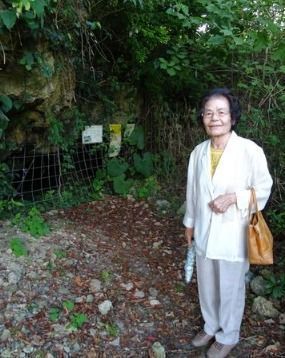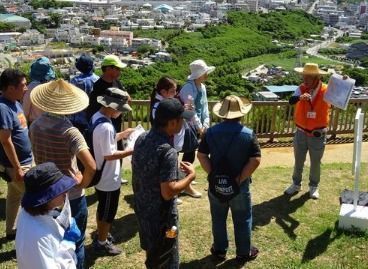Battle of Okinawa survivors tell of civilian losses not depicted in the film “Hacksaw Ridge”

Ms. Hatsue Hanashiro, who sought shelter in the “Kuchigwa Cave” near the Maeda escarpment, the site of a ferocious battle
August 16, 2017 Ryukyu Shimpo
June 24 saw the release of the film “Hacksaw Ridge,” which takes place at the Maeda escarpment in Urasoe, Okinawa, which was the site of ferocious fighting during the Battle of Okinawa.
Since the film’s release, tourists have flocked to weekend tours of the area, indicating a high level of interest.
These tours are conducted by the municipal tourism association.
However, no civilians appear in the film, which features U.S. military combat medic Desmond Doss as its protagonist and includes many battle scenes.
Ms. Hatsue Hanashiro, 85, of Urasoe survived the battle by taking refuge in a cave near the Maeda escarpment.
“I want people to know that in the battle of Okinawa, not only were countless lives of unarmed civilians lost; those who survived were also robbed of their hopes and dreams,” says Hanashiro.
At the end of March 1945, when U.S. naval gunfire and aerial bombing grew fierce in what was then Urasoe Village, Hanashiro and seven of her family members took shelter in the “Kuchigwa cave” within the grounds of Urasoe Castle, where the Maeda escarpment is located.
The family members with her were her grandmother, then 68, her mother, then 41, her younger sister, then 7, her younger brother, then 3, and three other relatives.
They had also considered escaping to the southern part of the island, but decided it would be too hard for her elderly grandmother and young brother to walk such a long distance, and instead took refuge in the Kuchigwa cave near their home.
The film “Hacksaw Ridge” depicts a ferocious shoot-out between U.S. and Japanese forces, and Hanashiro says that Japanese soldiers would emerge from among large trees near the Kuchigwa cave to fire cannons at their adversary.
She says that sometimes she would leave the cave to gather water, but adds, “I was targeted by machine-gun fire. I would lie on the ground pretending to be dead and wait for the U.S. aircraft to leave.”

A tour of the Maeda escarpment introducing “Hacksaw Ridge” and other features at the end of July in Urasoe, Okinawa
When the U.S. military shot shells near the cave, they emitted explosive noise and the ground shook.
The blast wave blew all the way into the cave, and Hanashiro says that when she looked up, pieces of human flesh were adhered to the ceiling of the cave.
“I didn’t know if it was from the body of a nearby Japanese soldier or a civilian, but I thought that hell must be what I was experiencing then,” says Hanashiro.
Hanashiro and her family had to live for an extended period of time without food or water. On May 5, 1945, she fled the cave and headed toward the well at her home, thinking that if she was going to die anyway, she at least wanted to drink her fill of water first.
When she left the cave, “there were blackened, swollen corpses everywhere,” she says. These must have been the bodies of the Japanese soldiers killed in the battle at the Maeda escarpment depicted in the film.
Hanashiro heard about the film “Hacksaw Ridge” from her daughter.
“I have no interest in seeing it. I don’t want to remember,” she says reticently.
Then, with strength, she says, “We must never make war again.”
(English translation by T&CT and Sandi Aritza)
Previous Article:Ginowan City Council demands Osprey flight suspension, investigation into Australia sea crash
Next Article:Ryukyu Kasuri Cooperative wins the Pola Traditional Culture Award
[Similar Articles]
- Maeda Escarpment used as the main stage of “Hacksaw Ridge.”
- Troubled by nightmares after the war, Hacksaw Ridge’s real life protagonist returned to Okinawa in 1995
- Toshie Asato, oldest person speaking of her Battle of Okinawa experiences and inspiration for film “GAMA”, dies at 99
- Praying for life-saving cave and peace at Shiohira Gongen Festival
- “Peace Walk” tour around Battle of Okinawa sites in Urasoe, Naha
 Webcam(Kokusai Street)
Webcam(Kokusai Street)


